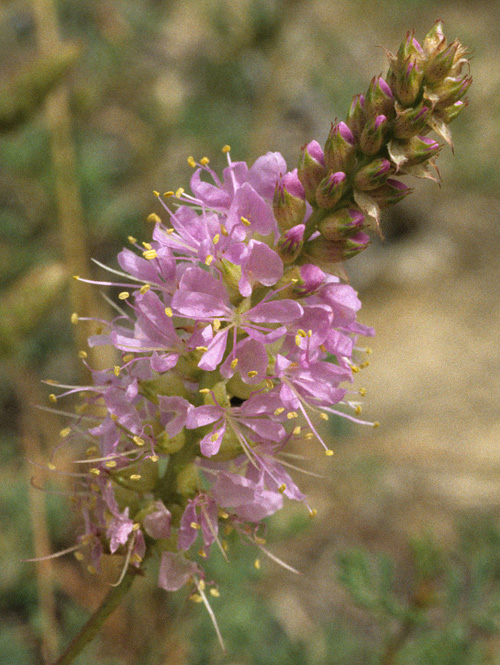Dalea scariosa
|
|
|
|
Family: Fabaceae
Albuquerque Prairie-Clover
[Petalostemon prostratus, morePetalostemon scariosus] |
Allred and Ivey 2012, Heil et al. 2013, Spellenberg 1999 (New Mexico Rare Plant Technical Council Website) Duration: Perennial Nativity: Native Lifeform: Forb/Herb General: Perennial herb, from a woody root crown; stems prostrate to decumbent-ascending, 30-80 cm long, glabrous and glandular, with a resinous scent. Leaves: Alternate and pinnately compund, 1-3 cm long, with 7-9 leaflets per leaf; leaflets 3-10 mm long and 1-5 mm wide, obovate to wedge-shaped and usually folded in half, flat or notched at the tip; leaflet surfaces glabrous and dotted with tiny glands. Flowers: Pink, in loose cylindric spikes 2-10 cm long, at branch tips; flowers about 1 cm long, with pea-flower morphology (papilionaceous), with a wide upper petal called the banner, two smaller lateral petals called the wings, and a boat-shaped lower petal called the keel which contains the style and stamens. Petals rose-pink; sepals 5, glabrous and glandular, united at the base into a tube 3-4 mm long, this topped with 5 ciliate teeth, 1-2 mm long. Fruits: Pods glabrous, small, and contained within the persistent calyx; containing 1 or 2 seeds. Ecology: Found on open sandy clay banks and bluffs, often along roadsides, from 4,500-6,500 ft (1372-1981 m); flowers August-September. Distribution: North-central New Mexico from the Socorro area north to Albuquerque and Jemez Springs. Notes: This pink- to pink-purple- flowered perennial Dalea is endemic to quite a small area, within 50 to 100 miles of Albuquerque. It is distinguished by its spreading, prostrate, herbaceous growth form; leaves with 3-4 pairs of wedge-shaped leaflets which often have notched tips; leaves and stems without hairs but dotted with light brown to greenish glands; pinkish flowers in loose cylinder-shaped spikes, with a bit of space between many of the flowers so that the central stalk of the inflorescence is visible; and calyxes that are glandular and mostly glabrous, with just the top edge fringed with hairs. Most similar to D. lanata but that species has stems and leaves covered with dense short hairs, making it look felty. D. scariosa is often locally abundant within its restricted area of distribution, frequently occurring on sites that were disturbed just a few years earlier. Ethnobotany: Unknown Etymology: Dalea is named for Samuel Dale (1659-1739) an English physician and botanist; scariosa means scarious, or thin, dry, papery, and not green, possibly alluding to the calyxes which dry to a brownish color. Editor: AHazelton 2017 |
|
|
|

